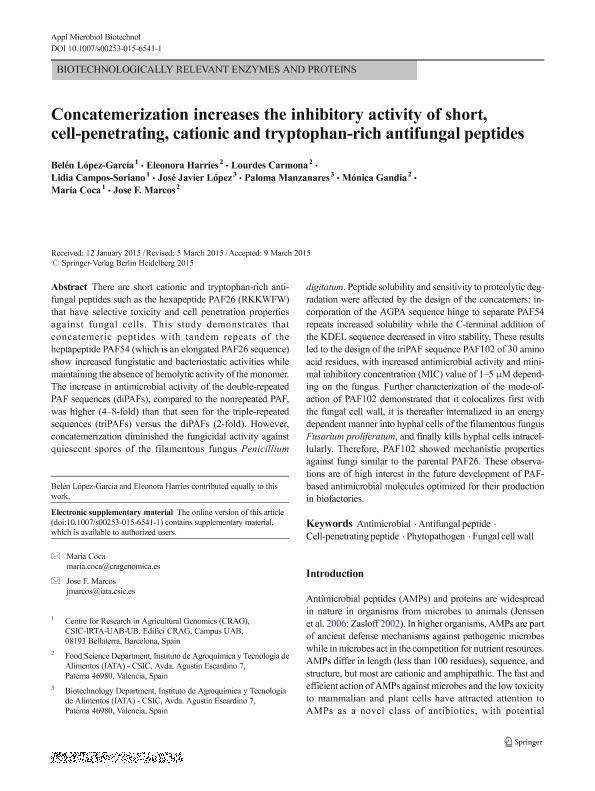Mostrar el registro sencillo del ítem
dc.contributor.author
Lopez Garcia, Belén
dc.contributor.author
Harries, Eleonora del Milagro

dc.contributor.author
Carmona, Lourdes
dc.contributor.author
Campos Soriano, Lidia
dc.contributor.author
López, José Javier
dc.contributor.author
Manzanares, Paloma
dc.contributor.author
Gandía, Mónica
dc.contributor.author
Coca, María
dc.contributor.author
Marcos, Jose F.
dc.date.available
2016-08-11T19:26:01Z
dc.date.issued
2015-04
dc.identifier.citation
Lopez Garcia, Belén; Harries, Eleonora del Milagro; Carmona, Lourdes; Campos Soriano, Lidia; López, José Javier; et al.; Concatemerization increases the inhibitory activity of short, cell-penetrating, cationic and tryptophan-rich antifungal peptides; Springer; Applied Microbiology And Biotechnology; 99; 19; 4-2015; 8011-8021
dc.identifier.issn
0175-7598
dc.identifier.uri
http://hdl.handle.net/11336/7106
dc.description.abstract
There are short cationic and tryptophan-rich antifungal peptides such as the hexapeptide PAF26 (RKKWFW) that have selective toxicity and cell penetration properties against fungal cells. This study demonstrates that concatemeric peptides with tandem repeats of the heptapeptide PAF54 (which is an elongated PAF26 sequence) show increased fungistatic and bacteriostatic activities while maintaining the absence of hemolytic activity of the monomer. The increase in antimicrobial activity of the double-repeated PAF sequences (diPAFs), compared to the nonrepeated PAF, was higher (4-8-fold) than that seen for the triple-repeated sequences (triPAFs) versus the diPAFs (2-fold). However, concatemerization diminished the fungicidal activity against quiescent spores of the filamentous fungus Penicillium digitatum. Peptide solubility and sensitivity to proteolytic degradation were affected by the design of the concatemers: incorporation of the AGPA sequence hinge to separate PAF54 repeats increased solubility while the C-terminal addition of the KDEL sequence decreased in vitro stability. These results led to the design of the triPAF sequence PAF102 of 30 amino acid residues, with increased antimicrobial activity and minimal inhibitory concentration (MIC) value of 1-5 μM depending on the fungus. Further characterization of the mode-of-action of PAF102 demonstrated that it colocalizes first with the fungal cell wall, it is thereafter internalized in an energy dependent manner into hyphal cells of the filamentous fungus Fusarium proliferatum, and finally kills hyphal cells intracellularly. Therefore, PAF102 showed mechanistic properties against fungi similar to the parental PAF26. These observations are of high interest in the future development of PAF-based antimicrobial molecules optimized for their production in biofactories.
dc.format
application/pdf
dc.language.iso
eng
dc.publisher
Springer

dc.rights
info:eu-repo/semantics/openAccess
dc.rights.uri
https://creativecommons.org/licenses/by-nc-sa/2.5/ar/
dc.subject
Antifungal
dc.subject
Peptide
dc.subject
Penicillium
dc.subject
Fusarium
dc.subject.classification
Biología Celular, Microbiología

dc.subject.classification
Ciencias Biológicas

dc.subject.classification
CIENCIAS NATURALES Y EXACTAS

dc.title
Concatemerization increases the inhibitory activity of short, cell-penetrating, cationic and tryptophan-rich antifungal peptides
dc.type
info:eu-repo/semantics/article
dc.type
info:ar-repo/semantics/artículo
dc.type
info:eu-repo/semantics/publishedVersion
dc.date.updated
2016-08-11T13:58:52Z
dc.journal.volume
99
dc.journal.number
19
dc.journal.pagination
8011-8021
dc.journal.pais
Alemania

dc.journal.ciudad
Berlin
dc.description.fil
Fil: Lopez Garcia, Belén. Consejo Superior de Investigaciones Cientificas. Centre for Research in Agricultural Genomics; España
dc.description.fil
Fil: Harries, Eleonora del Milagro. Consejo Superior de Investigaciones Cientificas. Instituto de Agroquimica y Tecnologia de Alimentos; España. Consejo Nacional de Investigaciones Científicas y Técnicas. Centro Científico Tecnológico Salta; Argentina
dc.description.fil
Fil: Carmona, Lourdes. Consejo Superior de Investigaciones Cientificas. Instituto de Agroquimica y Tecnologia de Alimentos; España
dc.description.fil
Fil: Campos Soriano, Lidia. Consejo Superior de Investigaciones Cientificas. Centre for Research in Agricultural Genomics; España
dc.description.fil
Fil: López, José Javier. Consejo Superior de Investigaciones Cientificas. Instituto de Agroquimica y Tecnologia de Alimentos; España
dc.description.fil
Fil: Manzanares, Paloma. Consejo Superior de Investigaciones Cientificas. Instituto de Agroquimica y Tecnologia de Alimentos; España
dc.description.fil
Fil: Gandía, Mónica. Consejo Superior de Investigaciones Cientificas. Instituto de Agroquimica y Tecnologia de Alimentos; España
dc.description.fil
Fil: Coca, María. Consejo Superior de Investigaciones Cientificas. Centre for Research in Agricultural Genomics; España
dc.description.fil
Fil: Marcos, Jose F.. Consejo Superior de Investigaciones Cientificas. Instituto de Agroquimica y Tecnologia de Alimentos; España
dc.journal.title
Applied Microbiology And Biotechnology

dc.relation.alternativeid
info:eu-repo/semantics/altIdentifier/url/http://link.springer.com/article/10.1007/s00253-015-6541-1
dc.relation.alternativeid
info:eu-repo/semantics/altIdentifier/doi/http://dx.doi.org/10.1007/s00253-015-6541-1
dc.relation.alternativeid
info:eu-repo/semantics/altIdentifier/doi/10.1007/s00253-015-6541-1
Archivos asociados
